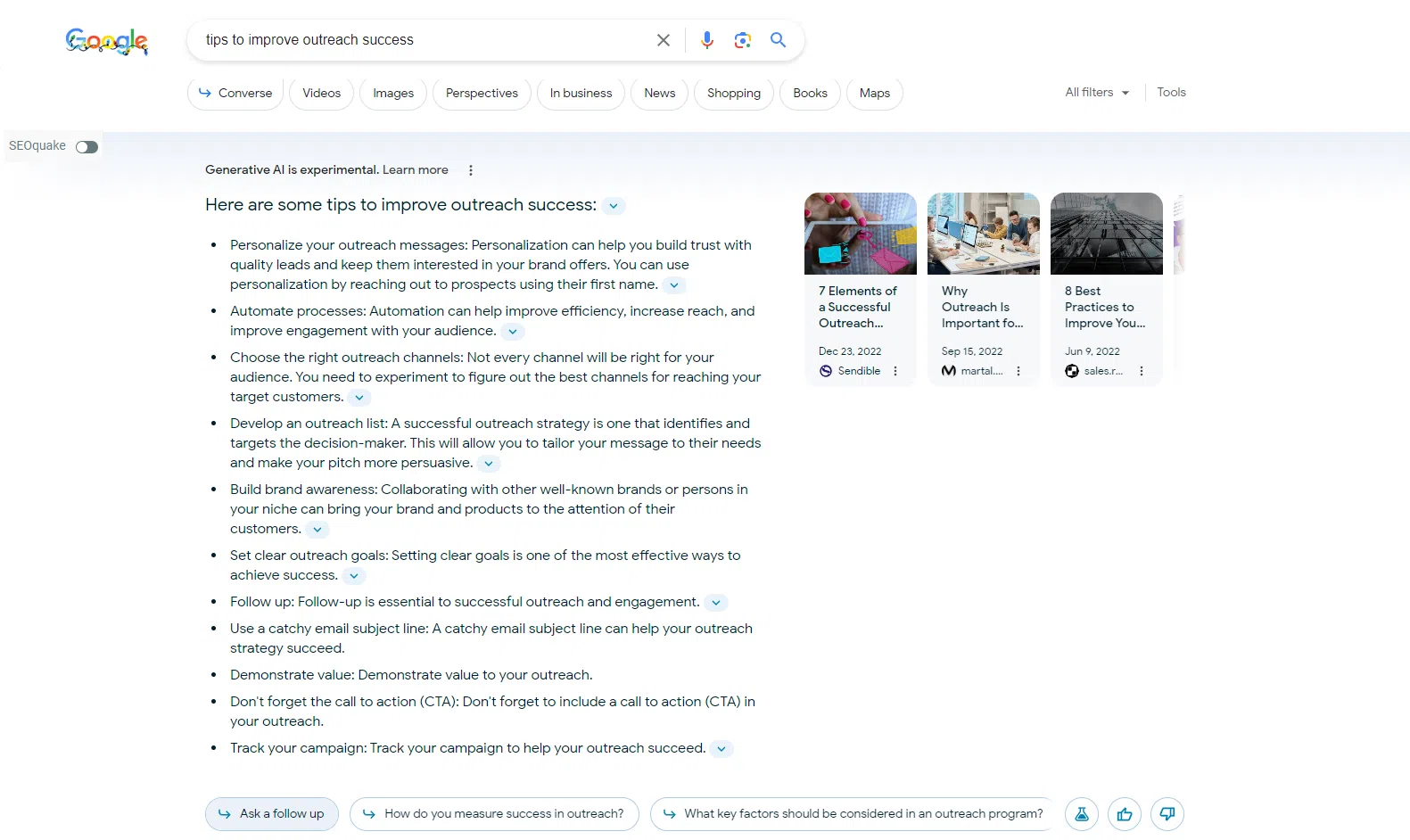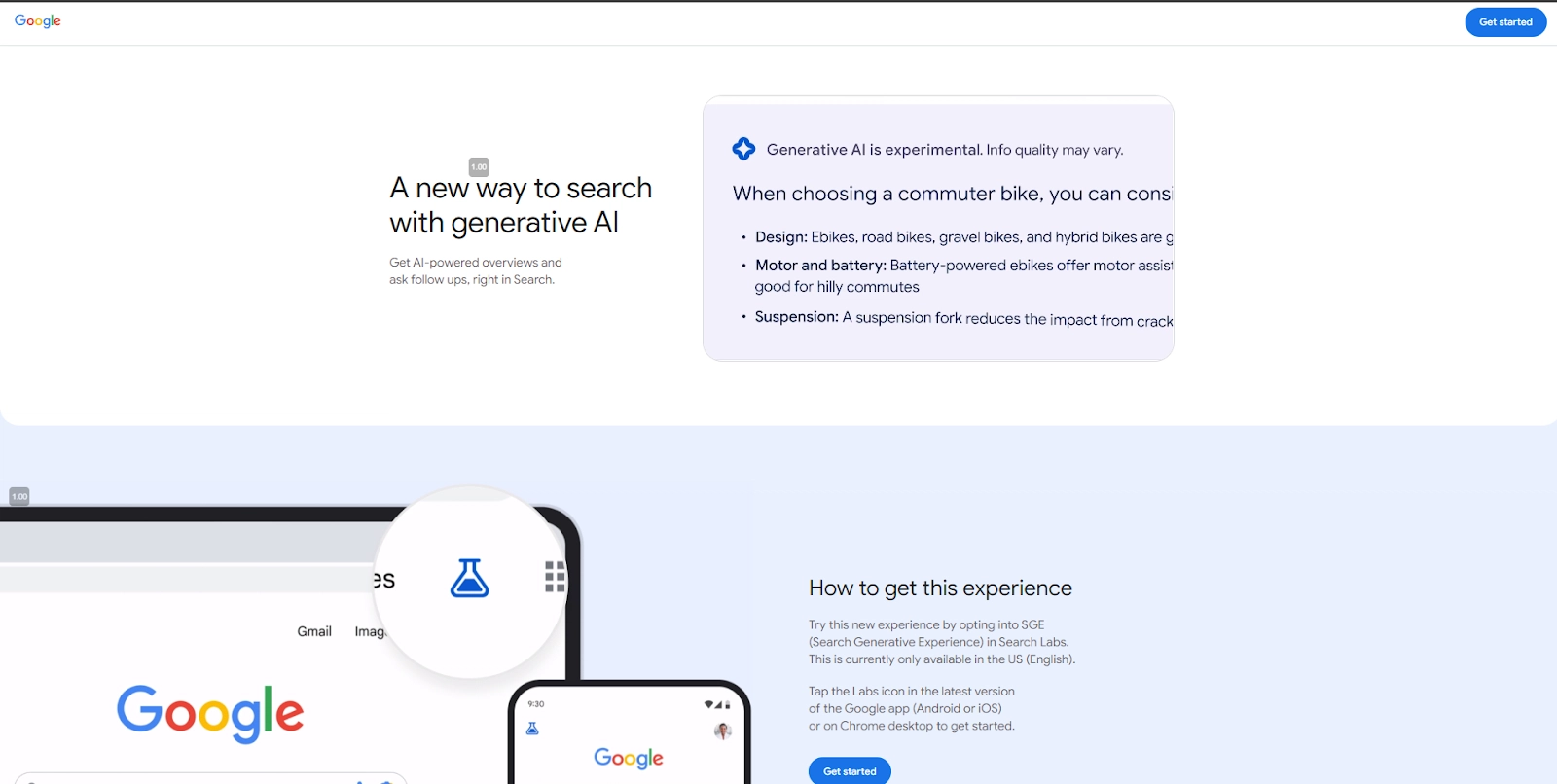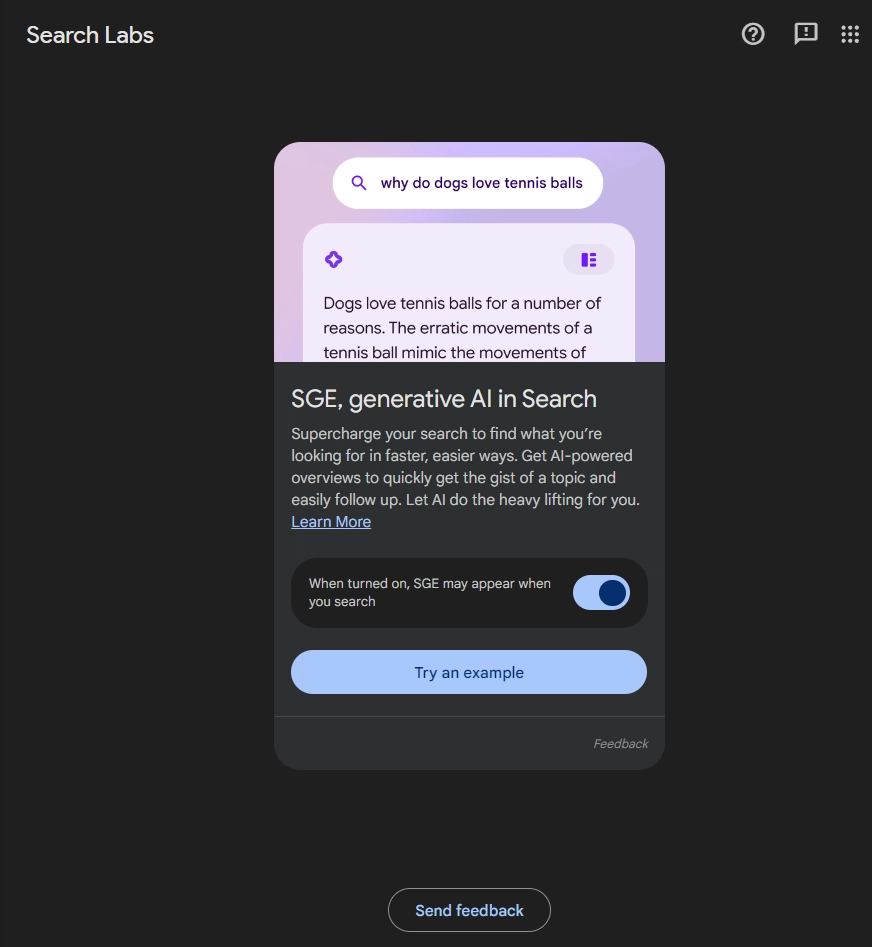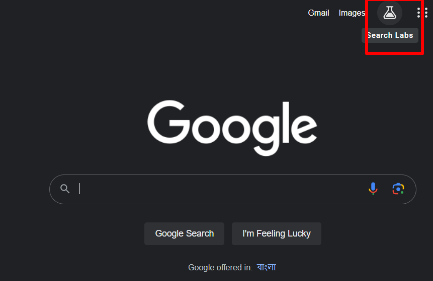Blogs
Practical Insights & Latest Happenings
Don’t miss out on the latest trends and info on SEO, search engines, social media, and more.
January 26, 2024
mothasim

Search Generative Experience (SGE) is a new seach update by Google where generative AI is used for a better user experience. Your website should be optimized for SGE as well fo best result, which means it should be a part of your SEO strategy.
If you are eager to know how to rank in Google’s Search Generative Experience (SGE), here is a details guide that you can easily follow even as a beginner.
Google’s Search Generative Experience (SGE) is a new approach to search results from Google that uses generative AI to provide users with quick and clear overviews of search topics, without having to click on individual webpages.
Instead of just matching keywords, SGE looks at full web pages and attempts to understand the overall context and meaning. It then generates content directly on the search results page to better answer the queries.
For example, if you search for “tips to improve outreach success,” SGE may generate a bullet point list of the top tips for outreach directly on the search results page. This provides a quicker answer for searchers without needing to click through to multiple sites.

For website owners and SEO professionals, optimizing for SGE will become increasingly important. Creating high-quality, in-depth content focused on informing searchers should be a priority.
Ranking well in SGE results can significantly help increase your visibility and traffic. As the technology develops further, websites producing original, comprehensive content will likely see gains.
Generative AI refers to algorithms or models that can create content, including text, images, audio, and even code.
These systems run on large language models (LLMs), which are trained on vast amounts of data. In the case of Google SGE, it uses this generative AI to provide users with quick and clear overviews of search topics. It builds on a knowledge graph and features snippet capabilities the search engine already has.
For instance, if a user is searching for what to do on a rainy day with elementary school kids, SGE can provide a summary of the top ideas for activities without the user having to click on individual webpages.
The goal of SGE is to reduce friction in the search process and help people find information faster. It aims to understand real-world queries and topics in order to provide the most useful information.
The main benefit of Google’s SGE is that it provides users with quick and clear overviews of search topics, saving them time and effort in clicking on individual webpages.
It also allows users to generate AI images and text by typing a prompt into the Google Search bar, working much in the same way as AI-powered text-to-image generators.
This is particularly useful when users need help with visualizing an idea. What’s more, SGE is designed to provide more personalized and context-aware search results, which can revolutionize customer service with greater efficiency and accuracy.
Before discussing how to rank in Google’s Search Generative Experience (SGE), let’s first know how to trun on your SGE.
To turn on Google’s Search Generative Experience (SGE) while searching on Google, you can follow these simple steps:
Using Chrome Browser:



Access Google Labs:
Enable SGE:
Try SGE:
After following these steps, you should be able to enjoy the benefits of SGE, including AI-powered overviews and the ability to ask follow-up questions in your search results.
The type of search queries that lead to Google’s Search Generative Experience (SGE) results include the following:
SGE responds to multi-angle queries by generating an unique response that draws information from several sources at once.
SGE is capable of generating ‘code blocks’ for tech-oriented searches, providing direct and practical information for such queries.
SGE is designed to provide quick answers to specific questions, such as finding answers, discovering topic overviews, summarizing key takeaways, and getting how-to instructions.
SGE presents related queries at the bottom of the SGE result, which, when selected, initiate a new SGE interaction in a conversational thread format.
In some cases, SGE may provide responses for queries that do not have available results in the traditional search format.
These types of queries trigger SGE results, and the feature is continually evolving to cater to a wide range of search intents and provide tailored and relevant information across various domains.
Ranking in Google’s Search Generative Experience (SGE) involves a few key steps. Here’s a simple guide to help you understand the process:
To optimize your content for Google’s Search Generative Experience (SGE), focus on creating high-quality, structured content that provides clear and comprehensive information.
Use schema markup to enhance the visibility of your content in SGE. Ensure that it aligns with the evolving capabilities of generative AI.
It’s also important to use natural language in your text and avoid excessive technical jargon or marketing buzzwords. SGE is trained on massive datasets of text and code, so using natural language helps it understand and respond to user queries more effectively.
What’s more, consider incorporating personal insights and addressing follow-up questions naturally within your content. This approach not only makes your material more engaging but also aligns with Google’s Search Quality Rater Guidelines, which can further enhance the visibility of your content in SGE.
When you are aiming to rank in Google’s Search Generative Experience (SGE), it’s important to focus on providing thorough and detailed answers to common user queries. SGE’s AI capabilities are designed to help users find information quickly and easily.
This is a chance for businesses to tailor content by addressing sub-questions related to the main topic. Use an in-depth approach to offer solutions to potential problems and detailed responses.
By addressing a wide range of related questions within your content, you can increase the likelihood of being featured in SGE snapshots and follow-up question features.
This means tailoring your content to have a meaningful conversation with SGE, offering in-depth solutions to potential problems, and answering related sub-questions. By doing so, you enhance the chances of your content being surfaced in SGE results, such as snapshots, follow-up questions, and topic summaries.
The concept of “easy read” or “readability” involves presenting text in a way that’s easy to understand, which is helpful for people with learning disabilities or those who may have trouble processing information.
This means using short, simple sentences and active voice, and avoiding complex words. It also includes using clear design and images to make the content easier to read.
Readability is important for user experience and is also a key factor in how search engines rank content. By making content more readable, it becomes more accessible and builds trust with the audience, leading to a better user experience.
To rank in Google’s Search Generative Experience (SGE), it’s essential to create content that aligns with the capabilities of SGE. This means providing clear and structured information that directly addresses complex user queries.
Think of it as tailoring your content to have a conversation with SGE, offering in-depth solutions to potential problems and answering related sub-questions.
By doing this, you increase the chances of your content being featured in SGE results, such as snapshots, follow-up questions, and topic summaries.
When structuring your content, try to simplify complex ideas and use clear, concise headings to imporve the clarity. This not only improves the user experience but also helps SGE understand and present your content accurately.
Also, focus on providing unique insights or data that set your content apart from others. This could involve original research, unique case studies, or innovative perspectives on familiar topics. By differentiating your content in this way, you enhance its relevance and value within the SGE environment.
When it comes to ranking in Google’s Search Generative Experience (SGE), incorporating visual elements into your content can significantly enhance the overall user experience and increase your chances of being featured in SGE-generated visual results.
Visual content, such as infographics, diagrams, and high-quality images, is now more important than ever, as SGE can generate images and is likely to prioritize visually engaging material.
By adding images, videos, and other visual elements to your content, you can make it easier for people and search engines to understand. This can help your content appear in more relevant searches and improve your SEO over time.
Also, since Google’s Search Generative Experience (SGE) aims to provide a more interactive and engaging search experience, using visual content can help capture and keep the attention of users.
So, it’s like making your content more attractive and easier to understand, which can help it show up in more searches and keep people interested.
Schema markup, also known as structured data, is like giving search engines extra info about your website’s content. This helps search engines understand and categorize your content better.
When you use schema markup, it can improve how your content shows up in search results, making it more visible. It’s kind of like providing search engines with a cheat sheet about your content, which can help it stand out more in search results.
When modifying your website content it’s important to consider SGE search results. SGE, a new form of search powered by generative AI, prioritizes brief, direct, and authoritative content.
By aligning your content with SGE’s preferences, you can enhance its visibility and ranking potential. Additionally, SGE provides citations to the content it pulls information from, offering an opportunity to elevate your content and boost its prominence.
To stay ahead, focus on creating a great user experience and experimenting with new ways to present your content. By adapting your content strategy to meet SGE’s criteria, you can position your content for success in this evolving search landscape.
To optimize your content for Google’s Search Generative Experience (SGE), it’s essential to stay informed about the evolving capabilities of generative AI and how they are integrated into SGE.
SGE is an AI-driven search engine that uses generative AI models (e.g. GPT architecture) to create information-rich, dynamic, and interactive search results.
In fact, the SGE results are different from traditional search results that offer users comprehensive answers directly within the search results while eliminating the need to navigate multiple pages.
To optimize for SGE, content creators and marketers should continually monitor how their content performs in SGE-generated results and adapt their content strategies to align with the preferences of SGE users.
To establish your brand as trustworthy and authoritative through high-quality backlinks, consider the following strategies from the search results.
First, evaluate potential link sources based on domain authority, domain age, and content quality. Older domains and high-quality, relevant content are more likely to enhance your site’s credibility and trustworthiness.
Additionally, you can replicate your competitors’ best backlinks and leverage tools like Help a Reporter Out (HARO) to become a source for reporters and bloggers, which can lead to backlinks from authority news sites and blogs.
By prioritizing quality over quantity and focusing on organic acquisition of backlinks, you can improve your site’s online reputation, brand awareness, and overall SEO performance, establishing your brand as a trusted and authoritative presence within your industry.
To optimize for emerging search experiences like SGE, stay updated on the latest SEO best practices. Keep learning as search algorithms and AI capabilities evolve.
Adapt SEO strategies based on new trends and innovations from Google. Proactively research and test potential optimizations as search morphs. Ongoing education in an ever-changing landscape is key.
Flexible SEO strategies will be best positioned to capitalize on new search technologies. Keep sharpening SEO skills and knowledge to rank well now and into the future.
It’s important to keep an eye on the queries that lead to SGE results and be ready to adjust your content strategy based on these insights.
By monitoring SGE queries, you can understand how users are interacting with the new search experience and tailor your content to better meet their needs.
Adapting to changes in SGE will help you stay relevant and maintain a strong presence in search results.
Now that you know how to rank in Google’s Search Generative Experience (SGE), you can see it requires an optimized user experience, mobile-friendly and fast-loading websites, closely matching content to search queries, providing simple and readable information, and building authority as a trusted source.